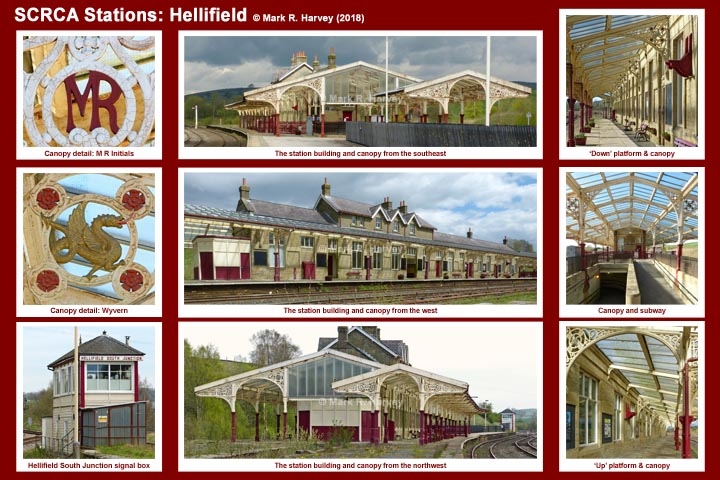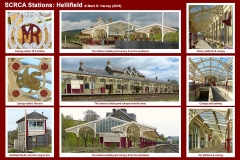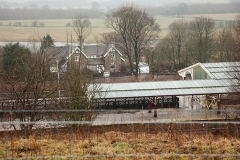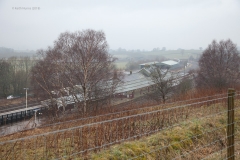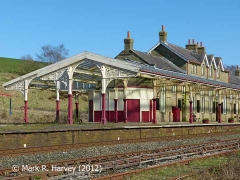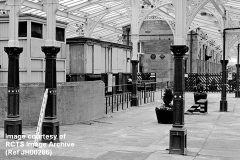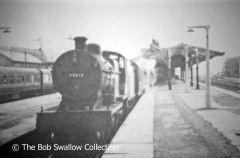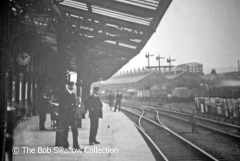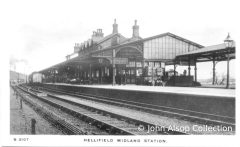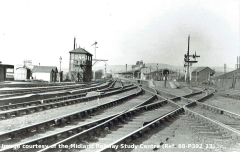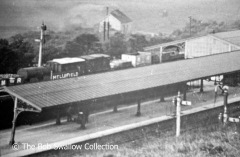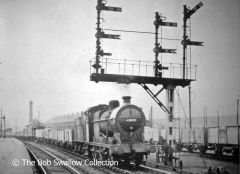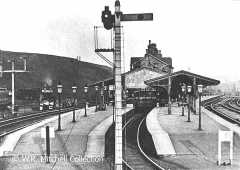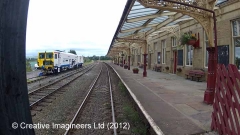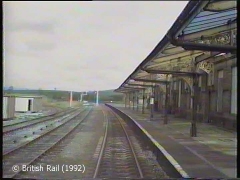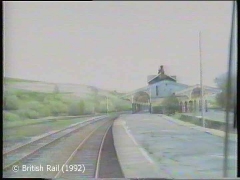The current Hellifield Station was built by the Midland Railway Company at a cost of £20,718[1] and it opened for passenger use on 1st June 1880[2]. Its extra long platforms and extra large station building allowed full trainloads of passengers to disembark briefly to obtain refreshments and to use the 'conveniences'. Both of these services were especially important during the early years of the station's operation because railway carriages did not have corridors, restaurant / buffet cars or, for third class passengers, toilets.
The booking hall and booking office were located at the south-eastern end of the main station building, near the access ramp from the entrance subway. The two-storey section housed a kitchen on the upper floor and a refreshment room on the lower floor, linked by a narrow staircase and a dumb waiter. A stone cellar below part of the refreshment room was used to store barrels of beer (which were delivered by rail and rolled into the cellar via a hatch set into the platform). The first full license (to serve alcohol) was granted on 24th August 1880. According to the 1894 edition of Cassell's "Official Guide to the Midland Railway", the station was also supplied with a letter-box, a telegraph office and a bookstall.
The sandstone blocks used to construct the main station building were quarried in Shipley (Airedale), but the platforms are surfaced with impressively sized flagstones from Burtersett (Wensleydale).
The glazed awning / platform canopy is a remarkable survivor, given its relative fragility and the high cost of maintenance.
Two locomotive depots were built beside the station: one for the Midland Railway Company (see Hellifield MPD) and one for the Lancashire and Yorkshire Railway Company. These enabled the locomotives to be quickly changed (for refuelling and servicing), thereby minimising the delay to through services. Both of these depots have since closed and almost all of the associated structures have been demolished.
The heyday for Hellifield was between 1901 and 1914. Taking 1910 as an example, around 60 uniformed station staff handled approximately 90 passenger trains a day. During the course of the same year, 28 engines and two snow ploughs were based at the Hellifield shed and the exchange sidings handled around 200,000 wagons. Services and staffing levels were significantly reduced during the First World War and they never quite recovered to the pre-war levels.
Traffic declined significantly during the 1960s and the condition of the station buildings began to deteriorate rapidly. The trackwork serving the south-eastern ('Up') bay was removed on 11th April 1965 and the trackwork serving the north-western ('Down') bay was removed on 2nd January 1966.
The station became an unstaffed halt in 1970.
Key parts of the passenger station were designated Grade II Listed on 7th April 1977. List Entry Number 1131702 specifically mentions the underground passage and ramp (including the associated gates, ceramic tiles and railings, the "main passenger building", the "extensive cast iron and glazed canopy", the 3rd class refreshement kiosk (described as a "C20 plank extension") and the weighing scales (described as "late-C19 cast iron weighbridge").
Between January and September 1994 (following the reprieve of the Settle-Carlisle line and the subsequent formation of the conservation area), the station building and platform canopy were restored at a cost of approximately half a million pounds.
The canopy was refurbished again during the second half of 2013 at a cost of £550,000. This involved repairing and redecorating the structural steelwork and replacing all of the glazing panels.
The platforms at the south-eastern end of the station are still served by trains operating daily passenger services as part of Britain's national rail network. The platforms at the north-western end of the station and the former station building have been leased to a private company. The building was originally designed to provide staff accommodation, booking facilities and a large refreshment room for rail passengers. It currently accommodates a popular cafe, visitor centre and holiday let. The glazed canopy has proved to be a significant asset for the cafe as it provides a covered outdoor seating area that boasts countryside views, with passing trains for added interest.
[2] The small North Yorkshire village of Hellifield has been served by two different railway stations. The current station is the second. For details of the first, see SCRCA site 230801: Hellifield (NWR) Station / Hellifield Goods Station. The exchange sidings beside the new station opened on 1st March 1880.

